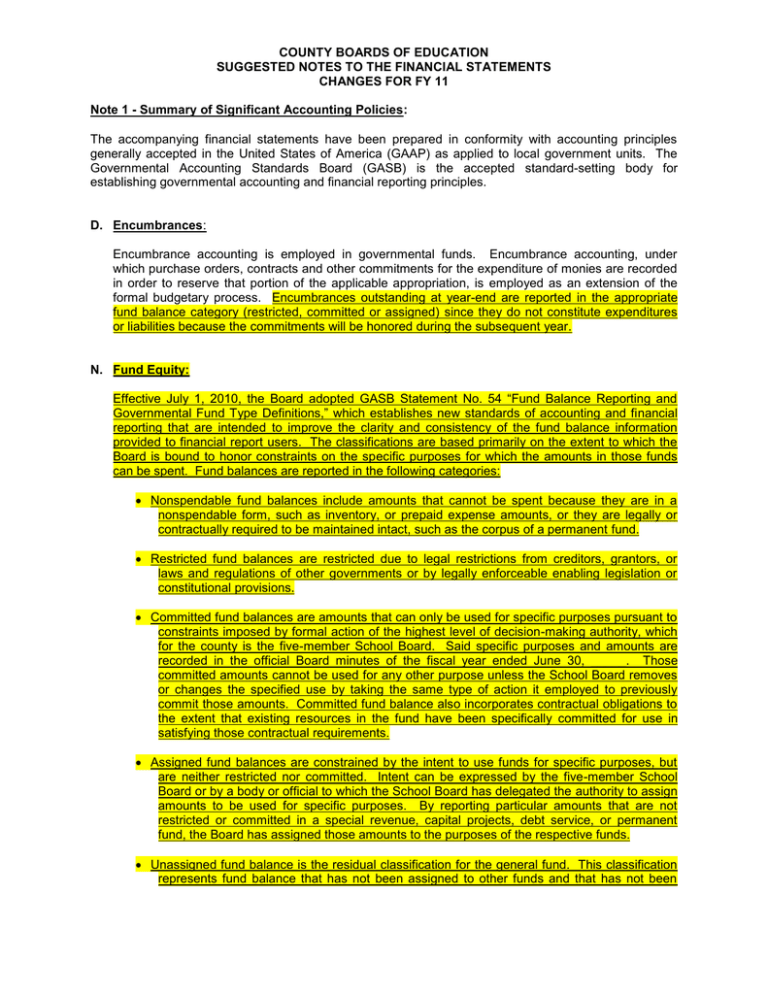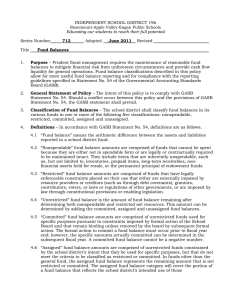COUNTY BOARDS OF EDUCATION SUGGESTED NOTES TO THE FINANCIAL STATEMENTS
advertisement

COUNTY BOARDS OF EDUCATION SUGGESTED NOTES TO THE FINANCIAL STATEMENTS CHANGES FOR FY 11 Note 1 - Summary of Significant Accounting Policies: The accompanying financial statements have been prepared in conformity with accounting principles generally accepted in the United States of America (GAAP) as applied to local government units. The Governmental Accounting Standards Board (GASB) is the accepted standard-setting body for establishing governmental accounting and financial reporting principles. D. Encumbrances: Encumbrance accounting is employed in governmental funds. Encumbrance accounting, under which purchase orders, contracts and other commitments for the expenditure of monies are recorded in order to reserve that portion of the applicable appropriation, is employed as an extension of the formal budgetary process. Encumbrances outstanding at year-end are reported in the appropriate fund balance category (restricted, committed or assigned) since they do not constitute expenditures or liabilities because the commitments will be honored during the subsequent year. N. Fund Equity: Effective July 1, 2010, the Board adopted GASB Statement No. 54 “Fund Balance Reporting and Governmental Fund Type Definitions,” which establishes new standards of accounting and financial reporting that are intended to improve the clarity and consistency of the fund balance information provided to financial report users. The classifications are based primarily on the extent to which the Board is bound to honor constraints on the specific purposes for which the amounts in those funds can be spent. Fund balances are reported in the following categories: Nonspendable fund balances include amounts that cannot be spent because they are in a nonspendable form, such as inventory, or prepaid expense amounts, or they are legally or contractually required to be maintained intact, such as the corpus of a permanent fund. Restricted fund balances are restricted due to legal restrictions from creditors, grantors, or laws and regulations of other governments or by legally enforceable enabling legislation or constitutional provisions. Committed fund balances are amounts that can only be used for specific purposes pursuant to constraints imposed by formal action of the highest level of decision-making authority, which for the county is the five-member School Board. Said specific purposes and amounts are recorded in the official Board minutes of the fiscal year ended June 30, _____. Those committed amounts cannot be used for any other purpose unless the School Board removes or changes the specified use by taking the same type of action it employed to previously commit those amounts. Committed fund balance also incorporates contractual obligations to the extent that existing resources in the fund have been specifically committed for use in satisfying those contractual requirements. Assigned fund balances are constrained by the intent to use funds for specific purposes, but are neither restricted nor committed. Intent can be expressed by the five-member School Board or by a body or official to which the School Board has delegated the authority to assign amounts to be used for specific purposes. By reporting particular amounts that are not restricted or committed in a special revenue, capital projects, debt service, or permanent fund, the Board has assigned those amounts to the purposes of the respective funds. Unassigned fund balance is the residual classification for the general fund. This classification represents fund balance that has not been assigned to other funds and that has not been restricted, committed, or assigned to specific purposes within the general fund. In other funds, any negative fund balances would be unassigned. Q. Restricted Resources: Restricted resources should be applied first when an expense is incurred for purposes for which both restricted and unrestricted net assets are available. If an expense is incurred for purposes for which committed, assigned and unassigned fund balances are all available, the fund balances should be reduced in the following order: committed, assigned, and then unassigned. Note 3 - Change in Accounting Policy: The Board changed its method of accounting for the following items in order to comply with accounting principles generally accepted in the United States of America: GASB 24 – As of July 1, 2010, the Board implemented GASB Statement No. 24, “Accounting and Financial Reporting for Certain Grants and Other Financial Assistance”. This statement requires the Board to record as a revenue and expenditure on behalf payments made by the State to the Consolidated Public Retirement Board for the unfunded liability of the Teachers Retirement System and disclose those amounts in the accompanying notes to the financial statements. GASB 54 – As of July 1, 2010, the Board implemented GASB Statement No. 54, “Fund Balance Reporting and Governmental Fund Type Definitions.” This statement changed the terminology used to describe fund balances in the governmental funds and expanded the disclosure of those new definitions in the accompanying notes to the financial statements of the Board for the year ended June 30, 2010. Note 10 - Employee Retirement System: Teachers' Defined Benefit Retirement System: Plan Description: The Teachers’ Defined Benefit Retirement System is a cost-sharing, multiple-employer public employee defined benefit retirement system which was established on July 1, 1941 and was closed for new members on July 1, 1991. Beginning July 1, 2005, all new employees become members of this plan. To qualify for full benefits, a member must be age 60 with at least five years of credited service, or be age 55 with at least 30 years of credited service or any age with at least 35 years of credited service. A member may receive a disability benefit after completing ten years of service, if the member is disabled for six months, unable to perform his or her regular occupation, and the Retirement Board expects the disability to be permanent. Upon retirement members select one of five benefit payment options. If a member terminates employment with at least five years of credited service, he may freeze his membership until he qualifies for retirement or he may withdraw his contributions from the plan. The employers’ contributions remain with the plan. Retirement benefits are based on two percent of the average member's five highest fiscal years of total earnings from covered employment during the member's last 15 years of service. The normal form of benefit is a single life annuity paid monthly, in an amount equal to 2% of the final average salary times years of credited service. Other forms of benefits may be elected subject to actuarial reduction: Cash Refund Annuity, 50% or 100% Contingent Joint and Survivor Annuities, and ten year Certain and Life Annuities. Pre-retirement death benefits are paid to the spouse of a deceased member who had attained the age 50 and completed 25 years of credited service. The annuity payment is computed as if the member had retired on the date of death with a 100% Joint and Survivor pension. If the member's age and service are less than that required, the sum of the accumulated member's and employer contributions with interest is paid to the member's beneficiary or estate. Funding Status: According to the 2010 Actuarial Valuation Report of the Teachers’ Retirement System, the plan’s actuarial unfunded liability was $ 4.8 billion as of July 1, 2010. Contribution Requirements and Payments Made: This is a fully qualified plan by the Internal Revenue Service. Therefore, all employee contributions are tax deferred. Participants contribute 6% of their gross compensation and the board of education contributes 15% of covered members’ gross compensation to the retirement plan, for a total of 21% annually for those who became members prior to July 1, 1991. Participants who became members after July 1, 2005 contribute 6% of their gross compensation and the board of education contributes 7.5% of covered members’ gross compensation to the retirement plan, for a total of 13.5% annually. The employers’ contributions are derived from state appropriations and county funds. Federally funded grant programs provide the funding for the employer contributions for salaries paid from federal grants. The required contributions for the year ended June 30, 2010, and the two previous years were: Year ended June 30, Required contributions Percent of current year covered payroll 2009 2010 2011 $ 404,547,000 $ 487,886,000 ________________ 25.89 % 29.57 % ______ The financial statements include amounts paid for/on behalf of the county by the State of West Virginia for the unfunded liability portion of retirement benefits. The for/on behalf payment for the year ended June 30, 2011 was $___________________. Teachers' Defined Contribution Retirement System: A unique feature of the Teachers' Defined Contribution Plan is that each member chooses the investment options and may make changes at the beginning of each calendar quarter. Seven investment options are provided from which a participant may choose in multiples of five percent. The investment options are: Orchard SecureFoundation Balanced, Orchard Lifetime 2015 Fund II, Orchard Lifetime 2025 Fund II, Orchard Lifetime 2035 Fund II, Orchard Lifetime 2045 Fund II, Orchard Lifetime 2055 Fund II, American Funds EuroPacific R5, Mutual Global Discovery Fund – Z, Heartland Value Plus Inst, Sentinel Small Company I, Vanguard Small-Cap Index Fund – Inv, Scout Mid Cap, Westcore Select, JHancock Large Cap Equity I, Putnam Equity Income Y, Vanguard Large Cap Index Inv, PIMCO Total Return Fund – Admin, TIAA-CREF High-Yield Inst, Vanguard Interm-Term Bond Index Fund and Valic Individually Allocated Fixed Annuity. Employees are eligible to participate from the date of employment. Employee contributions are fully vested, and employer contributions and earnings vest with the member as follows: one-third after 6 years, two-thirds after 9 years, and 100% after 12 years. The member is fully vested at death or disability. As of June 30, 2011, this plan had approximately $ ______ million in net assets for pension benefits. Retirement or disability benefits are based solely on the accumulation of dollars in the member's individual account at the time of retirement. The accounting administration of the Plan is the responsibility of Great West, an independent third party administrator. Note 11. Post Employment Benefits Other Than Pension: Based on the latest actuarial evaluation of the RHBT, the annual required contribution (ARC) for the State and the boards of education for fiscal year ended June 30, 2011 was determined to be: Total Amount/ Policy Holder Total Annual Required Contribution $ 816,274,000 $ 10,844 Pay as you go – Retiree Subsidy (145,671,196) (1,935) $670,602,804 $ 8,909 Remaining ARC Note 14 – Fund Balance The detailed components of the various fund balance categories as of June 30, ____ are as follows: Fund Balance Nonspendable: Inventory Prepaid Items Restricted for: Special Projects Capital Projects Debt Service Arbitrage Payments Excess Levies Committed to: TBD TBD Assigned to: Encumbrances TBD Unassigned Total Fund Balance General Current Expense Special Revenue Fund Special Revenue ARRA Fund Debt Service Fund Bond Construction Fund Permanent Improvement Fund Capital Projects Fund Total Governmental Note 15 - Commitments, Contingencies and Subsequent Events: The Board had encumbrances totaling $_____________ as of June 30, ___________ in the following funds: General Current Expense Special Revenue Fund Special Revenue ARRA Debt Service Fund Bond Construction Fund Permanent Improvement Fund Capital Projects Fund Encumbrances are classified as Restricted, Committed, or Assigned fund balance depending on the specific purpose of the encumbrance. During the fiscal year ended June 30, _____, the Board was awarded a grant of $ the School Building Authority (SBA) to finance the construction of __________________. from As of June 30, ______ the following commitments for construction and other capital improvements existed, which are included in the restricted fund balance reflected in the accompanying financial statements: $ Subsequent to June 30, ______, the following additional commitments for construction and other capital improvements have been entered into: $ During the fiscal year ended June 30, _____, the Board began pursuing legal action against the State of West Virginia to seek legislative funding through the Public School Support Program to offset the costs of providing other postemployment benefits to employees otherwise funded through the Program. If successful, the Board would receive funding sufficient to satisfy the current liability entitled “other postemployment benefits payable – state aid eligible employees” on the accompanying financial statement and to pay any future amounts billed by PEIA for state aid eligible employees. Changes to financial statement notes 11




